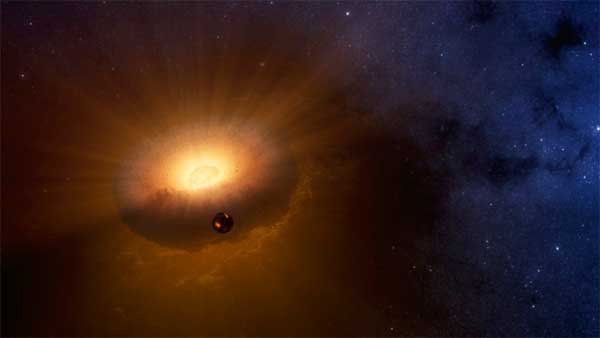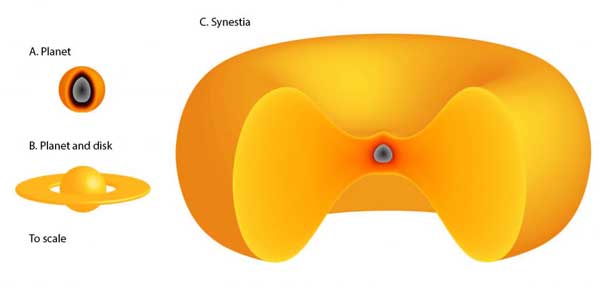From - Sky & Tlescope,
By - Monica Young,
Edited by - Amal Udawatta,

Sarah Stewart
A star’s sudden brightening and, two years later, its sudden dimming point to a cataclysmic collision between two large worlds.
Astronomers have caught two infant worlds slamming together around a young, Sun-like star more than 1,800 light-years away in the constellation Puppis. The impact probably vaporized both planets, creating a huge cloud of debris that still orbits the host star. Ultimately, the vaporized material will settle to form a new, much larger world — and astronomers are watching it all as it happens.
The planetary collision provides a rare glimpse into the violent world of planet formation, and it offers enticing opportunities for further study with the James Webb Space Telescope (JWST). But at first, study lead Matthew Kenworthy (Leiden University, The Netherlands) wasn’t sure what he was even looking at.
Kenworthy had been searching for something else entirely when, in late 2021, an alert on a fading star caught his eye. The All Sky Automated Survey for Supernovae (ASAS-SN), a league of 24 sky-monitoring telescopes, had sent out a notice regarding the star’s sudden dimming. Over the next several months, ASAS-SN recorded a ragged dive in brightness before the star’s brightness recovered to baseline.
“When this was announced by the ASASSN group, I started following the star’s changing brightness,” Kenworthy says. “I didn’t think of anything else until the Twitter post from [team member] Arttu [Sainio], who pointed out that the star had brightened up in the infrared some 1,000 days earlier.”
That clue ultimately led astronomers to the end of two young worlds — and the seed of a new, much larger planet made out of their remains. The resulting stream debris from that collision is what blocked the star’s light 2½ years later, in 2021. But it took time, and many more observations, to sort it all out.
BACKTRACK TO IMPACT
Kenworthy led a team that analyzed data collected by the Las Cumbres Observatory Global Telescope Network and the Wide-field Infrared Survey Explorer both before and after the sudden drop-off in the star’s light. The researchers found that 2½ years prior to the star’s sudden dimming, something had happened around the star to produce a new source of heat (and hence, infrared emission). Whatever occurred then, in 2018, warmed material to some 1000K (1,340°F) — and that material has stayed hot ever since.
To explain both the appearance of a new heat source in 2018 as well as the sudden dimming of the star in 2021, the team suggests in this week’s Nature that a giant impact occurred between two planets between super-Earths and sub-Neptunes in size. The worlds orbited somewhere between 2 and 16 astronomical units (a.u.) from the star; in the solar system, for reference, Mars orbits the Sun at 1.5 a.u. and Saturn at 9.5 a.u. The collision’s exact distance from the star isn’t precise, because it wasn’t measured directly from an image but rather estimated based on the light curves that follow the system’s changes in brightness.
The team acknowledges that it’s possible the infrared brightening and the starlight blockage were in fact two separate events, but they make the case that two such events would be even more rare than a planetary-scale collision.
Their calculations show that such a collision would vaporize both worlds, with a relatively small amount escaping to orbit the star. “Over the next few orbits (around a few hundred years), the dust will smear into a ring around the star,” Kenworthy explains. For now, the debris is in a long, giant cloud a quarter of an a.u. in size, and the dust is thick enough to block much of the star’s light as the cloud passes in front of it.
Most of the mass, though, has remained gravitationally bound, albeit in vaporized form. Team member Simon Lock (University of Bristol, UK) has previously proposed that such remnants might take the shape of a synestia, a donut-shape cloud with a bit of material straddling the middle (perhaps more akin to an extremely puffy Danish). This collision gives the researchers an opportunity to test that idea.

Simon Lock and Sarah Stewart
PLANETARY COLLISION OR DUSTY DISK?
“Observationally, there is no doubt that the scale (the amount of mass) in this violent collision breaks the record,” says Kate Su (University of Arizona), who was not part of the research team. “The question is, what's the ‘correct’ interpretation.”
Another team, led by Jonathan Marshall (Academia Sinica Institute of Astronomy and Astrophysics, Taiwan), has published a different explanation in the Astrophysical Journal, suggesting instead that an uneven dusty disk surrounds the star, perhaps originating in the breakup of comets. That team notes a marked similarity between this system and the curious Boyajian’s Star.
Both ideas could explain the observations, which simply shows that more work needs to be done. “This highlights the fact that we really know very little about giant collisions among exoplanetary systems,” Su adds.
More and better observations will help, with the most obvious route being JWST. Su notes that due to its distance, the system is on the fainter side; nevertheless, it’s within reach for the sharp-eyed infrared telescope.
Indeed, when the cloud has swung around the star a bit, Kenworthy plans to ask for time with JWST to try to detect the cloud directly, via reflected starlight. He’s looking forward to what they’ll be able to see: “It’s pretty exciting!”
Comments
Post a Comment